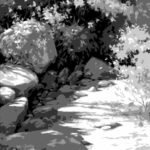Hello, Painting Friends,
I’ve been getting questions regarding composition. I’m happy to be getting that question since composition is such an important consideration – it’s right up there at the top of the list! However, that spot at the top must be shared with the element of mood and excitement, the emotion & vision that is unique to each of us and that only YOU can bring to YOUR painting. The “Nuts and Bolts” of painting must be balanced with Individual Personality.
Regardless of whether you are a beginning or advanced painter, here is a practice of preliminary study that will advance your compositional skills AND infuse the element of emotional content into your paintings!
Abstract vs. REALISM
 Here is my photo reference. The challenge is four-fold:
Here is my photo reference. The challenge is four-fold:
- Realistically represent the rocks, flowers, sun and shade.
- Convey feeling – the excitement of being surrounded by these glorious, golden flowers, the feel of the warm, spring sun and cool shade.
- Express the reality AND the illusory in my own personal painting style.
- Composition: maintain the first rule of composition & design which is asymmetry and create a value pattern.
To get loosened up, I painted this little abstract study – what an advantage it gave me!

- I did not concern myself with portraying any parts of the picture realistically. I squinted my eyes and sloshed in the colors and dark value pattern, then splattered white gouache.
- Instinctively I set the bottom boulder at a slant rather than the horizontal direction in the photo, which improved the composition.
- The quick, intuitive paint application allowed me the freedom to explore without worry the explosive action of the flowers contrasted with cool, blue shade that wasn’t exactly like the photo but what I saw in my mind’s eye.
- While it prepared me for the “real” painting, it was fun!

These three illustrations show the progression from photo-reference to abstract study to finished realistic painting. They have been “Photoshopped” so you don’t have to squint to see how the original value pattern has been carried through – but the darks also opened up to allow the viewer see into the shadows.
While I was using the abstract study to get in touch with the painting I had in mind on an emotional level, several extremely important Elements of Design were studied as well:
- value pattern – see how the darkest value creates a solid foundation for the basic composition
- asymmetry – asymmetrical design is achieved by placing shapes so that no shapes are centered nor equidistant
- movement – the linkage of shapes and values lead the eye through the painting
- repetition of similar shapes
- variation of shape and size within the assembly of repeated shapes
- color – color responsive to my emotional attachment to the location and memory of the day – and what I would call a “near-complement” color scheme
I consider this particular abstract study to be a finished painting in its own right. However, most of the studies of this nature I do are simply small sketch book studies. There are no rules except to relax and have fun with it. You simply must try it – it can make all the difference in the world!



Gloria Taylor Weinberg says
That’s lovely, and helpful to see your technique.
Stevie Denny says
This is a very helpful outline to crate a successful painting, Julie. I especially like the study to ensure the proper values within the chosen color scheme. Thank you for sharing.
Gloria E. Moses says
Thank you Julie for being so giving with your approach to composition. Doing the abstract/value/color reaction study quickly yields so much information, and will be a wonderful tool to incorporate in my painting process!